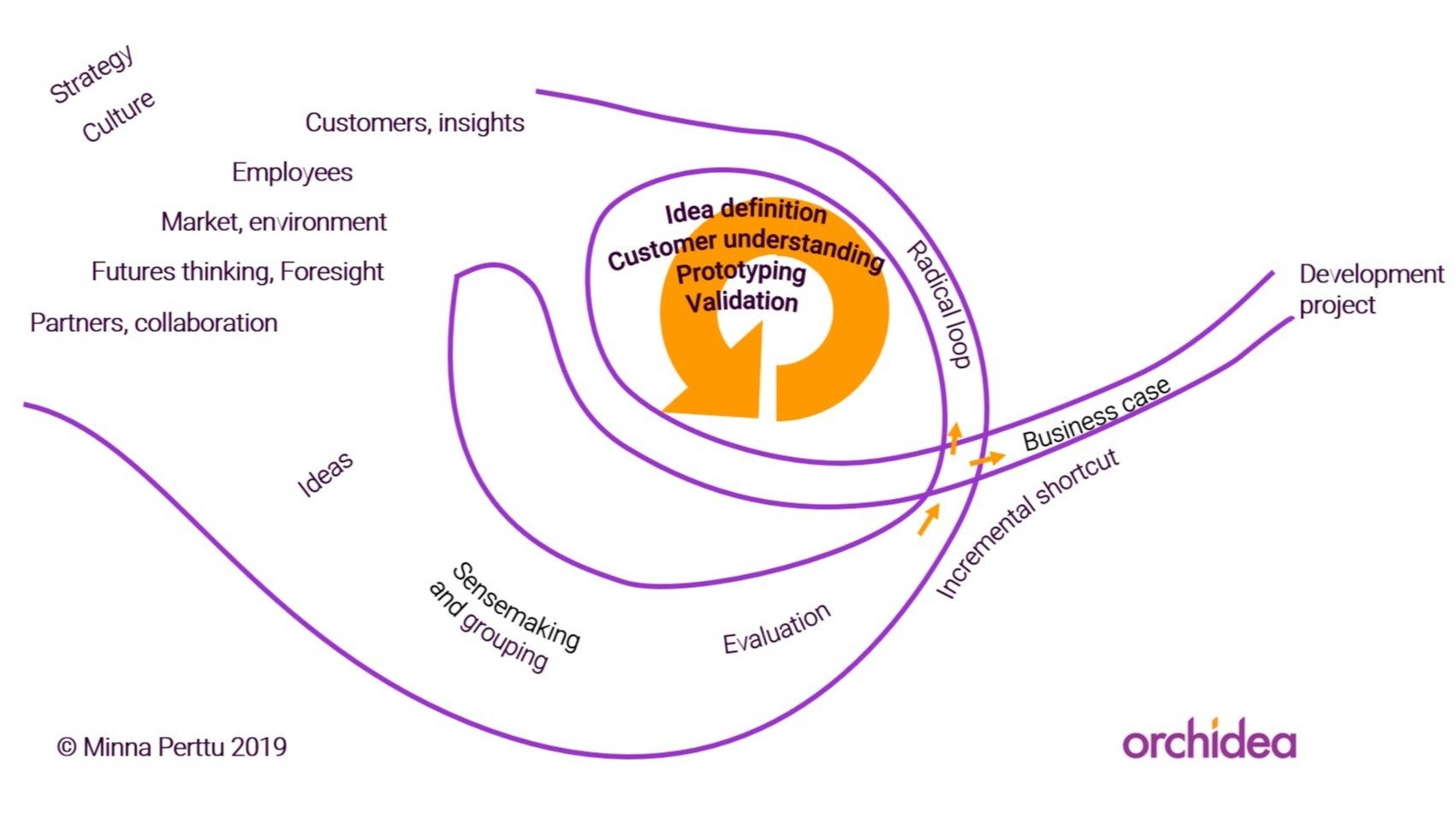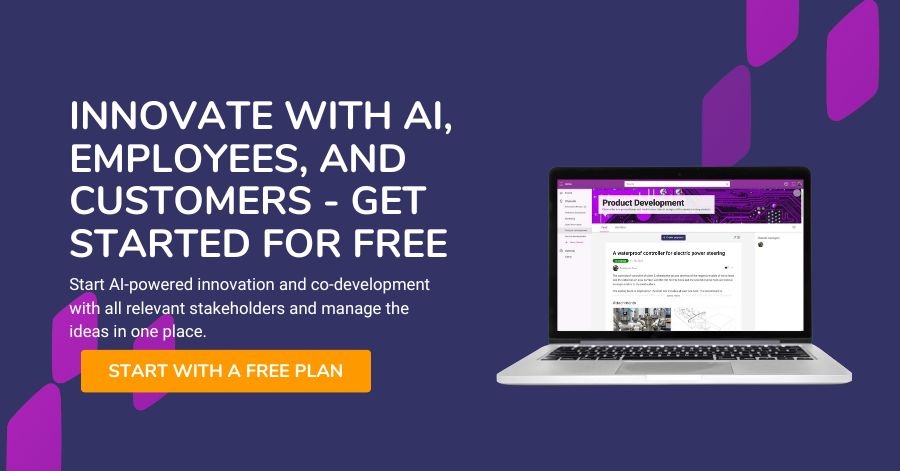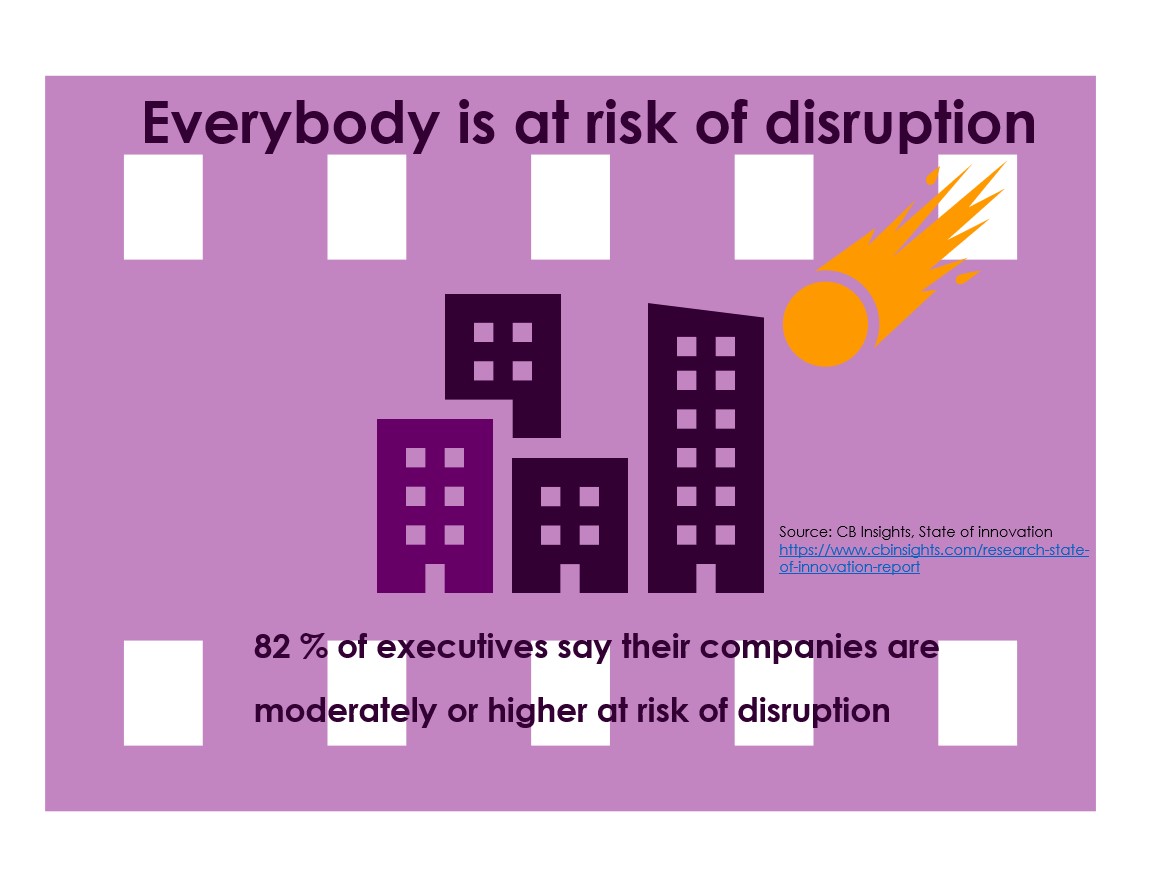New requirements for products and services are guided by megatrends, such as climate change, digitalization, urbanization, and growing middle class. Today, also the complexity of business and technology is increasing, and people and companies need to make sense of it. This is a clear trend in business that drives people to use design thinking methodologies like. Big companies like IBM and GE are using design thinking as a core competence for simplifying and humanizing their services. Large consulting organizations are also attending the design thinking journey by acquiring smaller design firms.
Front-end of innovation is often fuzzy and unstructured and the uncertainty is making it hard to push ideas further and make implementation decisions. To make things easier, I have gathered my top ten tips to make use of design thinking in a front-end of innovation process. I will first share some background and theory on the topic and then share tips based on my own research and hands-on experience.
Base for design thinking mindset comes from service-dominant logic
Traditionally the more goods you can produce and sell the better. The same is probably still valid but there are new ways of defining value instead of counting the sold items. Newer ways of thinking are defining the value as value in use. The focus of firms is shifting from product and service features to value.
The value is co-created with the firm and the customer when innovation or other resource is used. Therefore, service design and understanding of users and customers are hot topics in today’s business and many companies advertise that they are customer-centric. In 2004, Vargo and Lusch suggested a new dominant logic for marketing which emphasizes the individual service experience and co-creation of value.
The service-dominant (S-D) view of service is different than that of goods-dominant logic separating service and product innovation from each other. In S-D logic products are mechanisms or tools for delivering service.
Resources in S-D logic are divided into operant and operand resources. Operant resources are skills and knowledge, whereas operand skills are tangible assets, such as raw materials and production machines. Based on S-D logic all actors in the economy, firms, customers, organizations etc., are resource integrators
For gaining value, all resources need to be combined with other resources. Thus, innovations are a result of combining resources. In today’s business world where human resources are cut, and savings are constantly made, it seems that the operand resources are dominating the decision-making over the operant resources.

Service-dominant logic has four main arguments:
1. “Service is the fundamental basis of exchange”.
Skills, both mental and physical, can be exchanged among people. These skills can be used to make goods but still, basically the skill is what is being exchanged when exchanging goods for money for example. The receiving person could not make the good by himself, so he is paying the other for receiving the good or the specialized activity, skill, to make the good. Using money and selling goods looks like selling goods for money but as S-D logic sees it, we are exchanging services. Money and goods are only intermediates in exchange. When a person uses money to pay for services the money is enabling the service seller to buy other services.
People use natural resources to make tools that they use to deliver service. The value of a product doesn’t come from only owning it but also using it, the service the product provides.
2. “The customer is always a co-creator of value”.
The value of a product (service or item) is co-created together with the customer, as the real value comes from the demand for service from the customer. Thus, the firm creates value together with the customer for the service provided. The firm can only offer value propositions, invitations to engage with the firm for benefit. Activities of exchange are combined, over time to co-create value. The physical and technical enablers of product or service allow value propositions that can be either functional, e.g. this drill will help you drill a hole in the wall, or emotional, e.g. you will feel great after drilling because you accomplished something. Service experience is the sum of the functional and emotional outcomes of the service.
3. “All economic and social actors are resource integrators”.
Resource integration happens when someone creates resources (skills, knowledge, tangibles) by combining other resources. Resources can be something that can be bought, things that are exchanged in social networks or public resources. This way all actors are resource integrators. All the actors are co-creating value in the large system.
4. “Value is always uniquely and phenomenologically determined by the beneficiary”.
The experience is different every time the service is exchanged. The experience depends on the people receiving and providing the service and the circumstances. For example at a hairdresser, not all people feel good after a service of tinting their hair blue, but someone has always wanted that.
The basis of S-D logic is that value is co-created collaboratively. Consequently, dialogues and conversation enhance the effectiveness of service offerings. S-D logic is about applying resources for the benefit of others. When collaborating more and in a better way, firms can understand what the customer needs are and give better value propositions. Collaboration’s role is vital for service exchange since the service network is everywhere and drives collaboration. Enterprises can take advantage of networks and connectivity by organizing communities for their beneficiaries and this way co-create the firm’s value propositions.
To transform a company to be service-dominant, it needs to have a transparent and symmetric information exchange process and develop customer relationships with a long-term view. It should also think of goods as channels for exchanging operant resources and invest in skills and knowledge that are the basis for economic growth. The perspective needs to change in processes, roles and methods, and the focus has to be in the human-centered innovation and not so much on technology. Using design thinking for service innovation is a good starting point in the change.
Front-end of innovation
When talking about front-end of innovation (later: FEI), we need to understand the definition of innovation. It has been said that ”Innovation is where the worlds of business and creativity meet to create new value." It really is as simple as that. The key word here is definitely “value” since people talk about innovations when they mean ideas. Simply said, innovations are implemented ideas that create value.
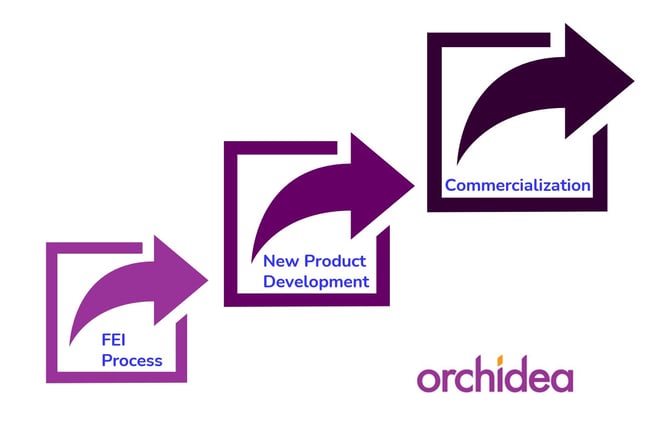
An innovation process is often divided into three sections. It starts with the FEI process, continues with the new product development process and ends with commercialization. The FEI process is often presented as a funnel that starts from an idea or problem identification, proceeds with idea enrichment, and ends with a concept description while being often very unstructured and nonlinear. FEI is the most critical part of the process considering strategy and decisions, judging which projects are to be implemented and which are not.
The top three key challenges in FEI are problem statement definition, uncertainty reduction by information management and stakeholder commitment. Design methods can help with these challenges. Traditionally the process starts from an idea and it is not thought much further.
What is the problem that could be answered by the idea and is it even a valid problem? The information flow between people related to innovations and ideas may not be very effective and it can cause a lot of uncertainty during projects. Sometimes poor stakeholder commitment in FEI is noticeable also e.g. by poor activity on decision making.
The decisions and choices made in the front-end phase are critical in the sense that they should be made having the best interests of the company and long-term strategic goals in mind. Only one-third of the innovation performance comes from innovation activities and more than half are constructed from organizational attributes, such as strategy, vision, culture, and senior management involvement. These organizational attributes affect decision-making and thus have a bigger impact on the company's performance.
There are distinct types of innovation: incremental and radical innovations. Incremental activities are, for instance, cost reductions, product line improvements, or efforts of repositioning. They rely on a thorough understanding of the markets. Radical activities can be defined as additions or extensions to product lines, new product lines or totally new products. A thorough and understandable business plan is critical for radical innovations because if the concept is not formulated well, it can hinder the development fundamentally. Companies that understand both new and current markets are more likely to succeed in the radical activities. Service design can be used to help in formulating concepts and business plans.
It has been stated that stage-gate, the traditional process model, and other hierarchical processes tend to kill innovation. Usually, these processes are also circled by a culture that kills innovation. Thus, an iterative design thinking process that could form a culture towards a more flexible one can be combined with the traditional stage-gate process in the FEI.
Design push for creating new innovations
There are two traditional knowledge sources in business innovation: market pull and technology push. In addition to these, we have a design push as an additional approach to get innovative solutions. Here, the drivers for innovation are new product meanings and the ability to understand and anticipate them. Each product has a value and meaning to the customers that can be communicated with them.
Radical design-driven innovations combine new technologies with the understanding of innovative meanings. Incremental design-driven innovations, on the other hand, can be created when acting only on the semantic dimension. This kind of differences are important to understand to communicate about design and its importance in a company properly.
Design thinking
The term design thinking was first used in 1987 by Peter Rowe used it in architecture design context. Later, and more related to business management, consulting company IDEO started to develop and use it. At that time design was thought as a visual finishing step of a product development project. Nowadays design thinking is used in product and service development, business development and even strategy creation.
In 2008, Tim Brown wrote a pioneering article about design thinking in Harvard Business Review. His design thinking definition is:
“It is a discipline that uses the designer’s sensibility and methods to match people’s needs with what is technologically feasible and what a viable business strategy can convert into customer value and market opportunity”.
I think that it opens up well the point of design thinking and its many-sidedness.
Design theory describes the design process as problem-centered, nonlinear and has a presence of uncertainty and choice. Design thinking uses the same theory base. Additionally, design thinking process is about collaborative creativity that is qualitatively oriented. It is becoming a basic skill set in the corporate world. An important factor differentiating design thinking from the other managerial ways of doing is the interest in the problem. The process is driven by hypothesis and it relies on iteration and learning through experimentation.
The power of design thinking is to large extent coming from the collaborative approach. By developing innovations with customers, it is possible to
- gain deeper knowledge about the customer’s and end-user’s needs,
- lower marketing costs since the testing is done with customers,
- decrease the risk since the result will fit the needs of the market better and increase trust with improved relationships.
Design thinking can make any company more human-centered and user-driven if it is used well. Design thinking helps in solving complex problems and creating new value from innovation. Thus, more and more companies are trusting design as their improvement in the field of innovation today. Bringing designer's toolkits and methods to the employees is not enough, but the new way of doing and thinking must be aligned with the company culture.
Innovation should be integrated across the whole company and design thinking can help with that. The remarks that the innovation process should be self-regulating, evidence-based and should not have too much bureaucracy, can be accomplished by using design thinking that includes strong teamwork based on evidence gained with customer understanding. Measuring the value of innovation is very important because it can change the attitudes towards innovation from creative and artistic leisure activity to be understood as a more scientific and systematic approach to making a profit for the company.
Service design and design thinking
Service design helps innovation and improvement of existing services and experiences by a multidisciplinary and holistic view. Customer experiences become more important as we live in a world where you can buy goods and services from anywhere in the world. All the layers around the basic item, such as delivery, can be made better and more enjoyable for the customer with service design. This leads to for example, good reviews in social media and hence, to more sales.
Different practitioners have different views of separating design thinking and service design from each other. Many have the opinion that words do not matter as far as everyone understands the things and processes they are working with. It could be beneficial to create a company name for the new way of doing, so that it would be felt like the company’s own way of doing.
In the service design field, there are many different visualizations of the service design process. The different models are all different and cannot be put in order of which one is the best or the worst. Nevertheless, they help us understand the basics of service design. Each designer can develop their own preferable model to work with. Each project starts differently, and all methods and process pictures will not fit to every project. All projects need to be planned separately and the processes applied according to the project.
All service design processes are based on a double diamond model (4 D model), which is a general design process developed by UK Design Council (2005). The model is based on two simple diamonds that describe divergent and convergent stages of the process.
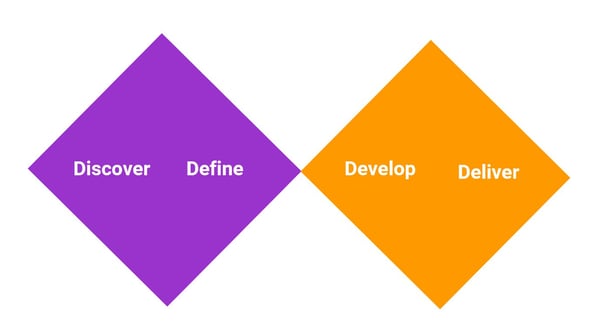
Service design Double Diamond model. A modification of the original model developed by UK Design Council (2005).
The first divergent part of the double diamond process describes the discovery phase where the designers are searching for new opportunities, market trends, and customer insights or some other information about the project topic. In this phase, the definition of the problem, user need or opportunity, and boundaries for the possible solution are starting to form. Both qualitative and quantitative research methods can be used.
In the second, Define, phase the information is processed and analyzed, filtered, and selected. The result is actionable tasks in a form of problem statements, that are formed from the selected opportunities, needs or problem spaces. They are also aligned with the needs and business objectives of the organization.
The next stage, Develop, is about solution generation, development, iteration and testing. Through an iterative process the potential solution is defined, prototyped and tested with customers as many times as needed for it to be ready for implementation. The idea is to try and learn to improve the ideas.
Finally, at the end of the process there is the delivery phase where the final concept is tested, produced and launched. This is when the offering starts to address the defined user needs from the discovery phase. This is also a good time to gather feedback on the offering and the design process itself.
The process is often represented as a linear process, but there is a possibility to go back to any other stage from any stage, in other words mix divergent and convergent thinking. We might realize in the development phase that we need more information from the customers. Then we go back to the beginning and learn more. In another case, we might find out that the prototype is not interesting enough for our customers, i.e, the prototype doesn’t provide enough value. Consequently, we return to the beginning and try again. This process may often take hundreds of rounds to make something valuable for both the customer and the company.
Service design process vs service innovation process
The service design process is not an innovation process and cannot be used straight in its original form in the innovation process. The value of service design can be discovered only when the innovation process is linked to it. In this way, its role can be very ground-breaking and meaningful to the company.
To make the innovation process and the design process in an organization work together, the design activities and methods must be described in a way that they fit with the innovation process. This way the new service design process may also include organizational activities in addition to design activities. This kind of work demonstrate and communicate service design as an approved and accepted approach and not only as separate activities. It is crucial to introduce these activities to the service implementation phase of projects.
10 tips for success
After bringing design thinking into use in a traditional manufacturing company and making a thesis study on the subject, I have gathered my top 10 tips for improving innovation with design thinking.
All in all, internal process development of companies should include evaluating the value and experience of the users. The company culture determines the language and habits that are normal in a company and thus, it is not easy to get people to understand or use a new process properly without making it their own.
1. Choose experienced, heterogeneous project team
24 % of innovation success is based on teams and collaboration. The persons taking part in projects should be those who work with the target customers or earlier solutions close to the project’s topic. In this way, we get the expertise to be there for you all the way. They also feel more motivated when they already know something of the topic.
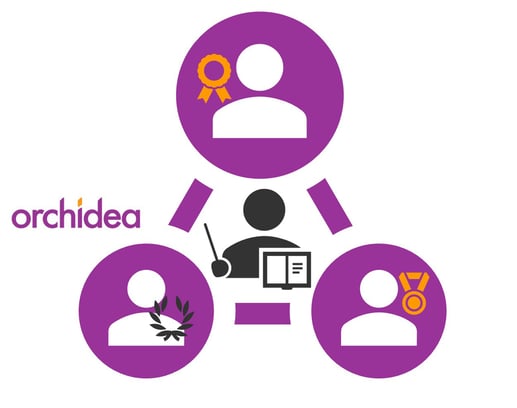
After development, it is easier to start sales when people from each function have been participating the project. The understanding is there. For example, marketing is more straightforward when you understand the customer value and not only hear about cool new technical features.
It proved to be effective to have a project manager from the business side and a facilitator / design lead who makes sure that the mindset and process are on a right track. The facilitator’s role is extremely important, If the old way of thinking and doing differs a lot from design thinking.
2. Give the team enough, but not too much time
People are always busy with their “normal” work and this new way of doing should be part of their “normal” work. In the beginning, they may feel that this is something extra on top of their workload, but if the topic is right for them, they will feel good about giving their time for this new way of working.
It is important to get people involved in the design thinking work by interviewing and participating in the interviews. This is the way to ensure that as many people as possible learn directly from the customers and create more customer-centric ideas. Involving the whole team can be an eye-opening experience on how little or much they actually learned from the project.
On the other hand, excessive amounts of time should not be spent on a project. For making design thinking effective and worth doing, each project should not take too long. Customer needs and ways of working change over time. If a development project where a design thinking framework is used takes years, there may be other solutions for improving the customer’s life or the problems may have disappeared. Giving too much time to a project enables people to get attached to ideas based on their own assumptions instead of totally focusing on the customers or users.
3. Use design thinking for fuzzy topics
Design thinking should be used when there is no clear understanding of how to move forward with a complex challenge, e.g. when the subject is vague and there is no knowledge of the customer's perspective on the subject. A design challenge is considered a good thing in design thinking projects. It can give more valuable information than a narrower topic. Of course, some defining must be done to frame the targets and goals of the project.
“I think it is easier to start with a broad topic and then tighten it up in the meantime. Otherwise you go to a customer and ask them something, and they are not interested. Then you really close the door and there is nothing more to discuss. But if you are more open, then everything is open”.
- Anonymous project participant
Topics for new design thinking projects can, for instance, be created by thinking about customer and market trends.
4. Listen and stay with the customers
Innovation best practice is to spend time with and interview your customers. This is indeed with the assumption that you actively listen to them. The time should not be spent telling them how to use your product, but really listening and observing. Usually, people like to speak about themselves and their work so give them the pleasure to do so. They are more willing to give their time to you when you are not trying to sell anything (at least yet). In addition, being part of development work is motivating for some customers.
“The broad topic opened up the discussion with the customers. They were very eager to tell about their work and their viewpoints. One interviewee commented that it was because “We were not selling anything but trying to find solutions for them”.
- Anonymous project participant
5. Document learnings and define hypothesis
To understand what is gained through the insight gathering from customers, make sure that you define and communicate the hypothesis well in the beginning and after the analysis. This way we know what is new and what we already knew beforehand.
Also, in the validation phase, it is important to write down what is to be tested and what is the hypothesis of the outcome. Otherwise, it will be difficult to prove that the work was worth doing. By clearly writing down the assumptions and hypothesis together with the project team decreases the illusion of claiming to have known something beforehand.
6. Allow all ideas
In a design thinking workshop, it is essential to also allow divergent thinking, i.e. share wicked problems, impossible and “stupid” ideas to stimulate the creativity of the team. The large idea pools for each customer problem offer the best ideas to bring value to the customer and the company itself. The more ideas, the more unique ideas there are.
When insight is the base for ideation, it is good to notice what kind of ideas are forming. Usually, the ideas are solutions for the found difficulties of the studied customers. In a company that has great products, this may lead to more service ideas. This is ok if the goal is to really help the customers and make their life better. This way the innovation truly comes from the customer needs and not from the product and creates customer value.
7. Understand the potential value for the customer
In complicated concepts, it may be difficult to understand all the potential value for the customer. This is where a concept value chart may come in handy. A concept value chart is a table that we developed to help map out the value of each concept module in each step of the customer journey. Thinking about the value, we may also compare different ideas with each other and thus make decision-making easier.
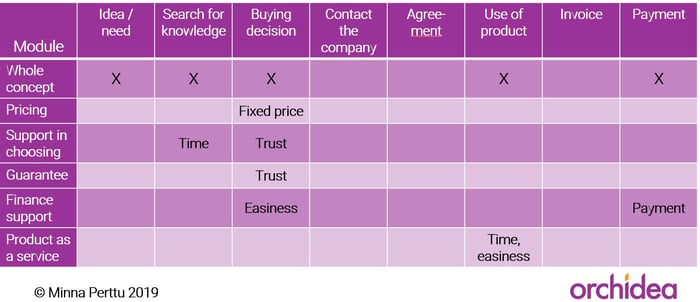
Above is a concept value chart of an example service. Service is divided into different service modules and the value from each of them is evaluated in each step of the customer experience.
8. Communicate the change clearly
Up to 53 % of the innovation success is based on organizational elements; vision, strategy, resources, culture and senior management involvement. Thus, it is crucial that the plan and vision of using a design thinking framework in the company is communicated well to the employees. People should understand why things are done in a new way and what kind of position design thinking should have in the company practices in the future. Business strategy and innovation strategy should guide the FEI activities. Also measuring should be thought about, organized and communicated.
The culture must approve the time used in creative activities as part of the normal workload. Communication from management should support this as well. Senior management should be involved in the FEI process mostly in the decision-making, but also by supporting the culture and assuring the needed resources.
Traditionally product and service design activities are conducted by different staff separately. Thus, there are often difficulties in increasing transparency and information sharing between these activities. Therefore, it is good to work in cross-functional teams to integrate product and service teams.
9. Visualize the process
For making people understand the process properly, they must experience it. The steps can be explained but to truly understand, one must try design thinking process in practice. Good visualization helps to understand and remember the process. The wording should also be in the company language for easier understanding.
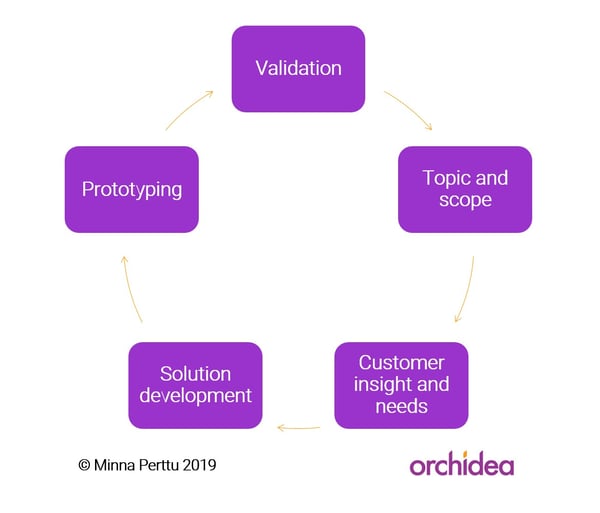
10. Connect the design thinking doing to the innovation process
To make design thinking work in a company’s FEI, it has to be connected to the business and innovation strategy. There should be a clear understanding of how different kinds of ideas will be taken further in order to define the FEI process at least on some level.
To connect design thinking to FEI, I sketched my version of the process. It shows that company culture and strategy are giving guidelines for the whole process. Continuous work with customers and insight gathering, own employees, market and environment research, foresight methods and collaboration with external partners are helping to create ideas. They also enrich the ideation phase and concept creation during the “radical loop” of the process.
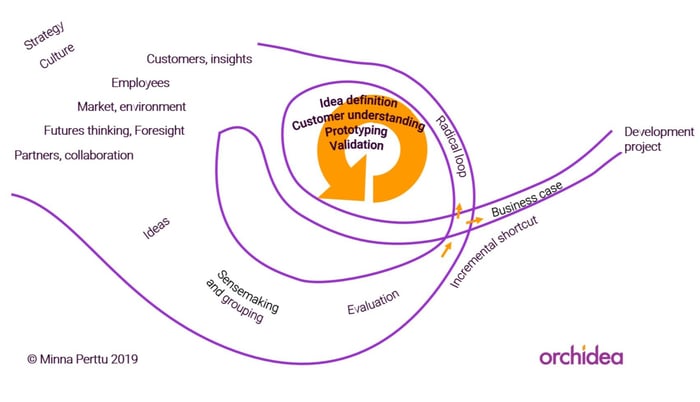
We can create radical design-driven innovation when we combine new technologies and understanding of innovative meanings. Incremental design driven innovations are made only on the semantic dimension. The radical loop will also provide incremental ideas, which can be implemented for the benefit of the customers. This is the design push approach to innovation.
The radical loop includes activities related to idea gathering. Customer insight gathering, market and environment research and futures thinking help to envision the concept to be able to create a business case. Customers, employees or partners can be all included in the radical loop activities. In addition, rapid prototyping and validation with customers should be executed in case of radical ideas. When using design thinking in the radical loop, there will be new ideas based on the insights and needs from this process. All new ideas, which are not going further in that project should be included in the idea funnel and be evaluated.
Design thinking is like the first phase of idea gathering in a traditional FEI process, but it is more systematic. In design thinking, the topic is already chosen and more information is already gathered for the ideation phase, due to insight gathering.
The perspectives of employees should be considered when developing processes alongside those of the company and other stakeholders. This requires an approach that consciously takes the employee experience into consideration in the development. The value is created when the employee experience is good, and an idea goes further efficiently, and the later stages of the innovation process can be used.
Read more on the subject and how I conducted the research for my thesis, http://urn.fi/URN:NBN:fi:amk-201902112200
About the author
 This blog post was written by Minna Perttu, who works in chemical industry. She has five years’ experience in innovation development. Minna has an MBA degree in Service Innovation and Design from Laurea and a previous degree in chemistry (Master of Science). Minna is passionate about human-centric development that guides businesses to create more value for themselves and their customers. Minna Perttu is intrigued of the complex structure of the FEI and aims at simplifying it without sacrificing its power and importance.
This blog post was written by Minna Perttu, who works in chemical industry. She has five years’ experience in innovation development. Minna has an MBA degree in Service Innovation and Design from Laurea and a previous degree in chemistry (Master of Science). Minna is passionate about human-centric development that guides businesses to create more value for themselves and their customers. Minna Perttu is intrigued of the complex structure of the FEI and aims at simplifying it without sacrificing its power and importance.
